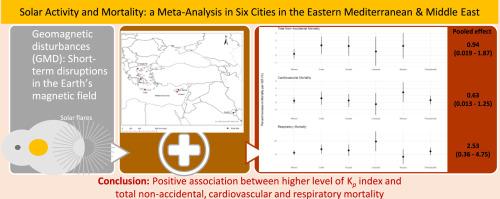太阳活动和死亡率:地中海东部和中东六个城市的荟萃分析
IF 3.4
Q2 ENVIRONMENTAL SCIENCES
引用次数: 0
摘要
太阳和地磁活动与人类健康的许多影响有关,包括心血管疾病(CVD)和总非意外死亡率。然而,在东地中海区域或中东尚未对这一情况进行评估。我们的研究旨在评估短期地磁干扰(GMD)对地中海东部和中东地区六个地点(雅典、塞萨洛尼基、克里特岛、希腊;科威特科威特市;利马索尔和尼科西亚,塞浦路斯)。方法采用时间序列分析方法,调整了1997年至2019年期间的温度和湿度,以估计GMD (Kp指数,太阳黑子数- SSN,等离子体β和行星际磁场- IMF)对每个研究区域的每日总非意外死亡率,心血管疾病死亡率和呼吸死亡率的影响。我们应用荟萃分析来估计所有地区的GMD死亡率效应。结果我们的分析包括在研究期间664,427例死亡。Kp指数与总死亡率、心血管疾病死亡率和呼吸系统死亡率显著相关。总非意外死亡率增加了0.94% (95% CI: 0.019, 1.87);心血管疾病死亡率增加0.63% (95% CI: 0.013, 1.25);呼吸系统死亡率增加2.53% (95% CI: 0.36, 4.75),每IQR增加Kp指数(IQR = 15.63)。然而,太阳活动参数(SSN, Plasma beta,或IMF)与死亡率没有统计学上的显著相关性。结论研究结果表明,暴露于较高水平的Kp指数与东地中海和中东地区的非意外、心血管疾病和呼吸系统死亡率之间存在关联。这些结果值得进一步探索,以确定太阳活动驱动的人体生理动力学的变化是否也可能与其他健康后果有关。本文章由计算机程序翻译,如有差异,请以英文原文为准。

Solar activity and mortality: a meta-analysis of six cities in the Eastern Mediterranean and Middle East
Background
Solar and geomagnetic activity have been linked to a multitude of impacts on human health including cardiovascular disease (CVD), and total non-accidental mortality. However, this has not been assessed in the Eastern Mediterranean Region or the Middle East. Our study aimed to assess the effects of short-term geomagnetic disturbances (GMD) on mortality in six locations across the Eastern Mediterranean and Middle East regions (Athens, Thessaloniki, Crete, Greece; Kuwait City, Kuwait; Limassol and Nicosia, Cyprus).
Methods
We used a time series analysis adjusted for temperature and humidity over the period between 1997 and 2019 to estimate the effects of GMD (Kp index, sunspot number - SSN, plasma beta, and interplanetary magnetic field - IMF) on daily total non-accidental, CVD, and respiratory mortality, for each study area. We applied meta-analysis to estimate the pooled GMD mortality effect across all locations.
Results
Our analysis included 664,427 deaths over the study period. Kp index was found to be significantly associated with total, CVD, and respiratory mortality. There was a 0.94 % (95 % CI: 0.019, 1.87) increase in total non-accidental mortality; a 0.63 % (95 % CI: 0.013, 1.25) increase in CVD mortality; and a 2.53 % (95 % CI: 0.36, 4.75) increase in respiratory mortality per IQR increase in Kp index (IQR = 15.63). However, solar activity parameters (SSN, Plasma beta, or IMF) were not statistically significantly associated with mortality.
Conclusions
Our findings indicate an association between exposure to higher levels of Kp index and total non-accidental, CVD and respiratory mortality in the Eastern Mediterranean and Middle East Regions. The results warrant additional exploration to ascertain if variations in solar activity-driven human physiological dynamics may also be linked to other health consequences.
求助全文
通过发布文献求助,成功后即可免费获取论文全文。
去求助
来源期刊

Atmospheric Environment: X
Environmental Science-Environmental Science (all)
CiteScore
8.00
自引率
0.00%
发文量
47
审稿时长
12 weeks
 求助内容:
求助内容: 应助结果提醒方式:
应助结果提醒方式:


